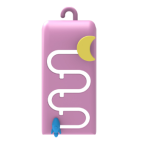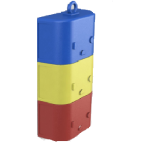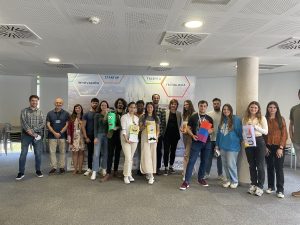The UJI.>LAB Challenge Kimibox emerged from the need to encourage and give strength to children and/or adolescents during the process of fighting cancer. Indirectly, it also encourages and gives strength to relatives and friends, as it gives their loved ones support and motivation from another perspective.
In this difficult context, psychological and social support must be provided in addition to medical care in the cancer treatment. The aim is to give patients strength, support and assistance in their fight against the disease.
Consequently, the main objective of the Kimibox project is to design and 3D print, with the assistance of the FabLab of Espaitec, a set of boxes to store doses of chemotherapy. The treatment bags are hidden behind the boxes and the designs alleviate the process of medication.
The UJI.>LAB Challenge Kimibox is aimed at students of Industrial Design at the UJI, who as “Solvers” propose potential solutions and designs for the Kimibox.
The project is funded by the Valencian Innovation Agency (AVI).
The UJI.>LAB Challenge Kimibox will be developed using the “Innovation Camp” methodology, based essentially on a combination of methodologies known as Design Thinking, Human Centred and Design Sprint. The characteristics of these methods are brought together to develop a process of innovation led by the interested parties in which participants explore, experiment, develop prototypes, discover and, above all, learn. Using these methodologies, the aim is to accelerate the design process, define the objectives, conceive/sketch potential solutions, decide which idea to carry out, create a prototype, and test it and validate it with real users (Design Sprint). All this is carried out with an innovative, person-centred approach, in which the problem to be solved is addressed in an integral way (Design Thinking) and bonds of empathy are sought with the people affected (Human Centred).
The methodology is applied in a collaborative way, so the solvers work in teams of 2 or 4 people. The formation of groups of solvers of different educational levels is promoted. It is compulsory for at least one team member to have the knowledge required to obtain a file in “.stl” format.
The challenge is open to the following participants as solvers: students from the second, third and fourth years of the Bachelor’s Degree in Industrial Design and students of the Master’s Degree in Design and Production of the UJI.
The number of places is limited to a maximum of 28 Solvers and/or a maximum of 7 teams. Places are allocated by order of registration.
The application period is from 28 February to 8 March 2022. Applications received after the above deadline or application forms that are not completed correctly will not be eligible.
DOCUMENTS TO BE ATTACHED IN THE REGISTRATION
Link: https://bit.ly/3v6kb5F
The UJI.>LAB Challenge Kimibox will be carried out by Espaitec, UJI’s Science and Technology Park at the Universitat Jaume I, from 11 March to 29 April 2022 in blended mode (face-to-face sessions and independent work). The face-to-face sessions will be held in the Espaitec multipurpose room2 and students should take their laptops with them.
STAGE 1: EXPLORE THE POTENTIAL SOLUTION
1 March (3.30 p.m., face-to-face): Presentation and start of the conceptual stage
Presentation of the Kimibox project
Preliminary preparation activities and formation of the solver teams
Talk: “Legal protection of ideas”
Start of the development of potential solutions
12 March (9.30 p.m., face-to-face): Development of the conceptual idea and selection of the Kimibox to be developed
Presentation (outline, sketches, etc.) of a maximum of three Kimibox ideas per team to select one of them.
STAGE 2: EXPERIMENT AND DEVELOP PROTOTYPES
14-31 March: Implementation of the idea by the Solvers. Independent work, not face-to-face.
Full Kimibox design
Creation of the material that is required (plans, files, etc.)
1 April (3:30 p.m., face-to-face): Selection of Kimibox
The presentation, which will be delivered using PowerPoint or other presentation software, should cover the following aspects:
1. Prototype of Kimibox designed in 3D from various perspectives
2. Explanation of the aesthetic aspect and the expected emotional impact
3. Functionality: durability and suitability in a health setting
4. Strengths and weaknesses of the prototype
5. Innovation in the Kimibox and creativity: competitive advantages, added value and elements that differentiate the prototype
6. Solution for the challenge of joining the two or more parts that make up the Kimibox
7. Technical feasibility: capacity and possibility of mass producing the design
4-13 April (FabLab facilities): Production of Kimibox in the FabLab
29 March (3.30 p.m., face-to-face): Submission of Kimibox and prize giving.
The Kimibox will be evaluated by health professionals together with various experts in the area of Design and Espaitec, in accordance with the following assessment criteria:
Evaluation by health professionals
Criterion 1: Aesthetic impact (from 1 to 5 points)
Criterion 2: Emotional impact of the design on the children or adolescents who are undergoing treatment (from 1 to 15 points)
Criterion 3*: Functionality: durability and suitability in the health setting (from 1 to 15 points)
Evaluation by experts in the area of Design
Criterion 4: Innovation of the Kimibox and creativity (from 1 to 10 points)
Criterion 5: Technical feasibility: the design’s capacity and feasibility for mass production (from 1 to 10 points)
Criterion 6: solution to the challenge of joining the two or more parts that make up the Kimibox (from 1 to 5 points)
Assessment by those responsible for Espaitec
Criterion 7: capacity for synthesis in the Elevator pitch (from 1 to 5 points)
*In Criterion 3, special attention will be paid to the design of the assembly. Designs that propose simple assembly systems so that the Kimibox can be cleaned and sterilised quickly and effectively will have a higher score. In addition, merit will be given to designs that consider the possibility of Kimiboxes fitting into each other to avoid losing parts and to save storage space.
MINIMUM REQUIREMENT FOR THE KIMIBOX:
(a) Material: polylactic acid (PLA). The material will be provided by Espaitec.
(b) Structure: the Kimibox has two or more parts that should be joined to make the box. This structure should cover only the front part and both sides. The back should not be covered and should be accessible to handle the treatment bags. In addition, the structure should have an upper part with a hole in it so that the treatment bags can be hung up. To draw up the design, the operating dimensions of the 3D printer should be considered: 145×145×175 mm.
(c) Dimensions of the treatment bag: 330 mm high and 160 mm long.
(d) Joints and design*: the Kimibox joints and the design itself should not have any sharp corners or any other type of flaw that could damage the treatment bag.
* Kimibox whose designs could have a negative effect on the administration of the treatment, or the durability of the bag, will not be selected or produced.
PRIZES FOR PARTICIPATING:
A €15 FNAC voucher for each participating solver
An Espaitec merchandising kit
A certificate of participation
Attendance at a 3D printing with filament course, at beginners’ level, carried out in the FabLab
KIMIBOX WINNING PRIZE:
€75 FNAC voucher for each participating solver who is a member of the team
Opportunity to participate in UJI.>Emprèn OnSocial
If a solver interrupts their participation in the UJI.>LAB Challenge – Kimibox, they renounce any type of participation benefit or prize, in the case that their team’s design wins.
Stage 1: Explore the potential solution
On 1 March, the first stage of the UJI.>LAB Challenge started. In this session, four solver teams were formed that participated in the entire development of the Challenge: the Actívate, Faraday Power, JAMBOT and Kandinsky teams.
In this stage, which took place in two consecutive sessions, the solvers had the opportunity to ask health staff from HGUC about the problem to clarify any doubts that they had, and to start to work on the conceptual idea that they eventually developed. The solvers developed their proposals using the Innovation Camps methodology through a graphic aid that helped them to define the problem and consequently propose the best solution. So that the solvers could develop at least one feasible idea in the health setting, each team proposed up to a maximum of three ideas. Those responsible from the HGUC selected the most appropriate and aesthetically attractive of these ideas. In addition, the solvers could attend the talk “Legal protection of ideas”.
Stage 2: Experiment and prototype
The following stage of the Challenge was devoted to experimenting and developing the prototype. It was carried out in a blended mode (independent and face-to-face work) in March and April 2022. At the start of this stage, the solvers had 18 days to completely design the idea independently. They had to finalise all aspects of the design, create the .stl files required for 3D printing, and prepare the Elevator pitch presentation.
The Kimibox proposals for each of the Solvers groups were as follows:




In the face-to-face session on 1 April, each team of solvers used an Elevator pitch to present their final proposal for the Kimibox. They stressed each of the aspects stipulated in the call for applications.
Finally, the solvers attended Espaitec’s FabLab on several days to make prototypes of their Kimibox designs by means of 3D printing. In some cases, the design had to be readjusted to attain the expected finishes. Hence, this stage was particularly critical as it provided solvers with the opportunity to become aware of the real production problems in their design. It therefore allowed additional learning as alternatives and readjustments in the design had to be made.
Stage 3: Discover and learn
At the session on 29 March, the Solvers delivered the Kimibox prototypes to HGUC so that they could be validated in a real setting. In addition, on that day, conclusions were drawn and reflections made on the development of the UJI.>LAB Challenge Kimibox.

The winning Kimibox was the proposal developed by the team JAMBOT, although a runner-up prize was given to the team Faraday Power. Below, you can see a promotional video of the winning Kimibox.
Validation at the HGUC (Hospital General Universitario Castelló)
To validate the functionality in a real health setting, the Kimiboxes that were designed and produced by the solvers were validated in the paediatric oncology department of the HGUC with children who are undergoing treatment. For this purpose, the aspects listed below were tested and assessed in the four Kimibox proposals obtained in the UJI.>LAB Challenge:
– Emotional impact of the Kimibox design on children or adolescents during the treatment
– Assembly system
– Storage system
– Convenience of the Kimibox as regards the cleaning and/or sterilisation process
– Durability
– Suitability in the health setting (corners, sharp areas) that could damage the bag for administering the treatment